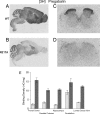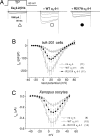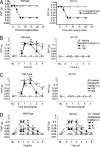Identification of the alpha2-delta-1 subunit of voltage-dependent calcium channels as a molecular target for pain mediating the analgesic actions of pregabalin
- PMID: 17088553
- PMCID: PMC1859964
- DOI: 10.1073/pnas.0409066103
Identification of the alpha2-delta-1 subunit of voltage-dependent calcium channels as a molecular target for pain mediating the analgesic actions of pregabalin
Abstract
Neuropathic pain is a debilitating condition affecting millions of people around the world and is defined as pain that follows a lesion or dysfunction of the nervous system. This type of pain is difficult to treat, but the novel compounds pregabalin (Lyrica) and gabapentin (Neurontin) have proven clinical efficacy. Unlike traditional analgesics such as nonsteroidal antiinflammatory drugs or narcotics, these agents have no frank antiinflammatory actions and no effect on physiological pain. Although extensive preclinical studies have led to a number of suggestions, until recently their mechanism of action has not been clearly defined. Here, we describe studies on the analgesic effects of pregabalin in a mutant mouse containing a single-point mutation within the gene encoding a specific auxiliary subunit protein (alpha2-delta-1) of voltage-dependent calcium channels. The mice demonstrate normal pain phenotypes and typical responses to other analgesic drugs. We show that the mutation leads to a significant reduction in the binding affinity of pregabalin in the brain and spinal cord and the loss of its analgesic efficacy. These studies show conclusively that the analgesic actions of pregabalin are mediated through the alpha2-delta-1 subunit of voltage-gated calcium channels and establish this subunit as a therapeutic target for pain control.
Conflict of interest statement
A Conflict of interest statement: M.J.F., P.J.C., E.S., H.M., J.O., T.-Z.S., S.B., L.C., S.E., J.W., R.A.K., T.W., and D.W. are scientists in the employment of Pfizer Research and Development and own stock/have stock options for Pfizer Inc.
Figures





Similar articles
-
Calcium channel alpha2-delta type 1 subunit is the major binding protein for pregabalin in neocortex, hippocampus, amygdala, and spinal cord: an ex vivo autoradiographic study in alpha2-delta type 1 genetically modified mice.Brain Res. 2006 Feb 23;1075(1):68-80. doi: 10.1016/j.brainres.2005.12.084. Epub 2006 Feb 3. Brain Res. 2006. PMID: 16460711
-
Pharmacology and mechanism of action of pregabalin: the calcium channel alpha2-delta (alpha2-delta) subunit as a target for antiepileptic drug discovery.Epilepsy Res. 2007 Feb;73(2):137-50. doi: 10.1016/j.eplepsyres.2006.09.008. Epub 2006 Nov 28. Epilepsy Res. 2007. PMID: 17126531 Review.
-
Pregabalin is a potent and selective ligand for α(2)δ-1 and α(2)δ-2 calcium channel subunits.Eur J Pharmacol. 2011 Sep 30;667(1-3):80-90. doi: 10.1016/j.ejphar.2011.05.054. Epub 2011 Jun 1. Eur J Pharmacol. 2011. PMID: 21651903
-
The alpha2-delta protein: an auxiliary subunit of voltage-dependent calcium channels as a recognized drug target.Curr Opin Investig Drugs. 2010 Jul;11(7):761-70. Curr Opin Investig Drugs. 2010. PMID: 20571971 Review.
-
Anxiolytic-like activity of pregabalin in the Vogel conflict test in α2δ-1 (R217A) and α2δ-2 (R279A) mouse mutants.J Pharmacol Exp Ther. 2011 Aug;338(2):615-21. doi: 10.1124/jpet.111.180976. Epub 2011 May 10. J Pharmacol Exp Ther. 2011. PMID: 21558437
Cited by
-
Skeletal Functions of Voltage Sensitive Calcium Channels.Curr Osteoporos Rep. 2021 Apr;19(2):206-221. doi: 10.1007/s11914-020-00647-7. Epub 2021 Mar 15. Curr Osteoporos Rep. 2021. PMID: 33721180 Free PMC article. Review.
-
Thrombospondin-4 reduces binding affinity of [(3)H]-gabapentin to calcium-channel α2δ-1-subunit but does not interact with α2δ-1 on the cell-surface when co-expressed.Sci Rep. 2016 Apr 14;6:24531. doi: 10.1038/srep24531. Sci Rep. 2016. PMID: 27076051 Free PMC article.
-
The importance of cache domains in α2δ proteins and the basis for their gabapentinoid selectivity.Channels (Austin). 2023 Dec;17(1):2167563. doi: 10.1080/19336950.2023.2167563. Channels (Austin). 2023. PMID: 36735378 Free PMC article.
-
Increased α2δ-1-NMDA receptor coupling potentiates glutamatergic input to spinal dorsal horn neurons in chemotherapy-induced neuropathic pain.J Neurochem. 2019 Jan;148(2):252-274. doi: 10.1111/jnc.14627. Epub 2018 Dec 21. J Neurochem. 2019. PMID: 30431158 Free PMC article.
-
Peripheral Voltage-Gated Cation Channels in Neuropathic Pain and Their Potential as Therapeutic Targets.Front Pain Res (Lausanne). 2021 Dec 13;2:750583. doi: 10.3389/fpain.2021.750583. eCollection 2021. Front Pain Res (Lausanne). 2021. PMID: 35295464 Free PMC article. Review.
References
-
- Dworkin RH, Corbin AE, Young JP, Jr, Sharma U, LaMoreaux L, Bockbrader H, Garofalo EA, Poole RM. Neurology. 2003;60:1274–1283. - PubMed
-
- Farrar JT, Young JP, Jr, LaMoreaux L, Werth JL, Poole RM. Pain. 2001;94:149–158. - PubMed
-
- Selak I. Curr Opin Invest Drugs. 2001;2:828–834. - PubMed
-
- Lauria-Horner BA, Pohl RB. Exp Opin Invest Drugs. 2003;12:663–672. - PubMed
-
- Pande AC, Davidson JR, Jefferson JW, Janney CA, Katzelnick DJ, Weisler RH, Greist JH, Sutherland SM. J Clin Psychopharmacol. 1999;19:341–348. - PubMed
Publication types
MeSH terms
Substances
Grants and funding
LinkOut - more resources
Full Text Sources
Other Literature Sources
Medical
Molecular Biology Databases

